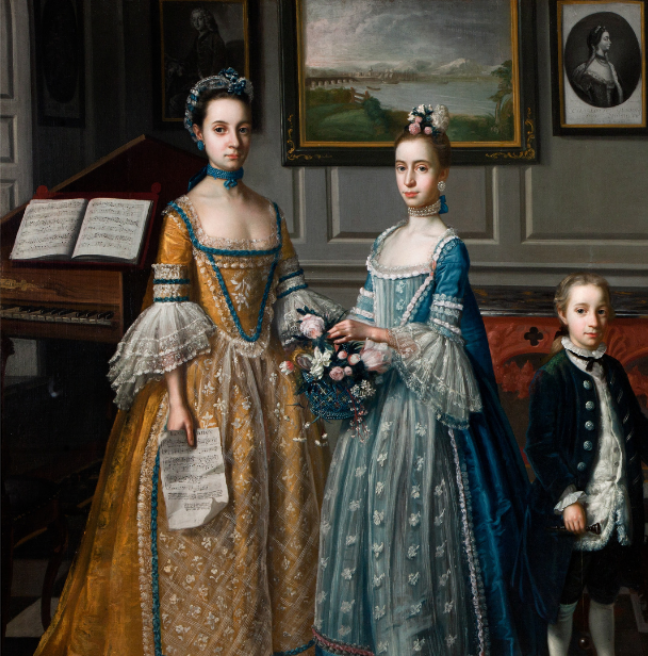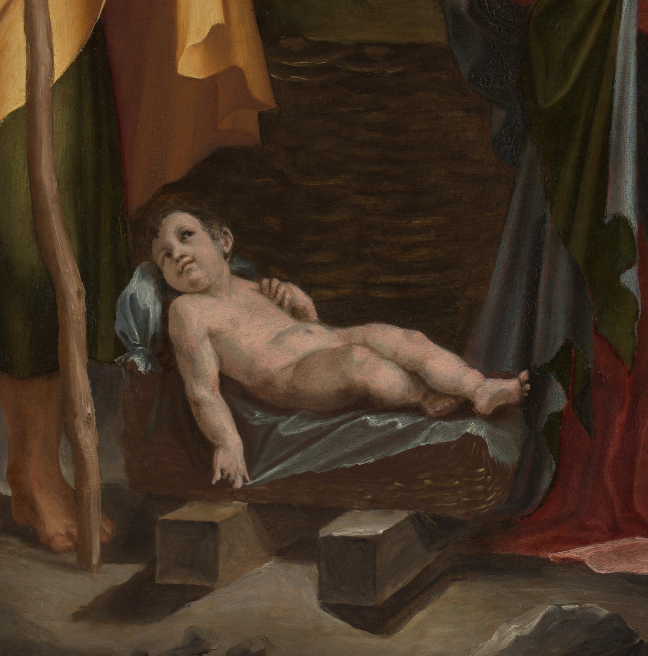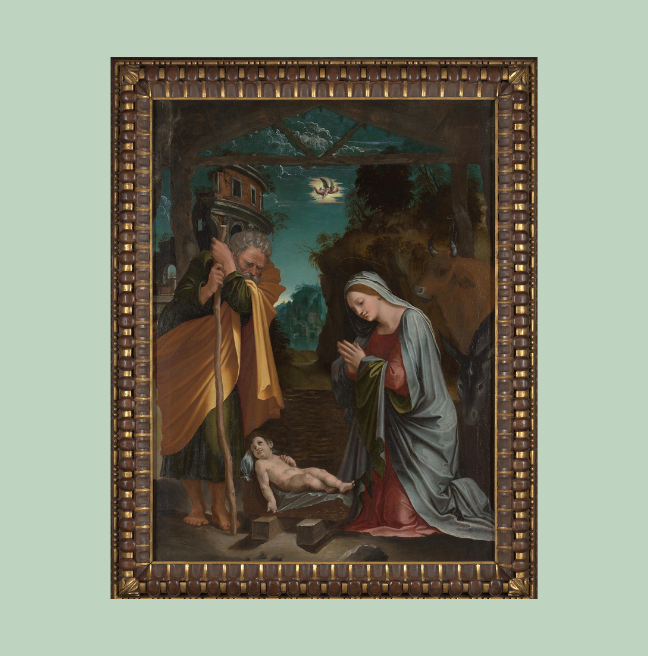
Renaissance to Romanticism
The finest pre-1900 Irish, British and European paintings in the Ulster Museum collection, including Peruzzi's 'The Nativity'.
'Renaissance to Romanticism' (Art Galleries 1 & 2) draws together many of the Ulster Museum’s finest pre-1900 paintings. Since 2017, a series of major acquisitions have entered the collection by gift, acceptance in lieu of tax, or grant-aided purchase. This display celebrates their arrival.
The first gallery gives an overview of European painting. This begins with a Renaissance Nativity by Baldassarre Peruzzi and the emergence, during the 1500s, of oil painting in Italy and Flanders (modern Belgium). This ground-breaking innovation gave artists greater freedom to experiment when depicting light and the natural world. During the 1600s, a revolutionary artistic movement took place in the Dutch Netherlands where landscape painting, often revealing a heightened sensitivity to light and the atmospheric effects of weather, developed as an independent subject. During the 1700s, the art of ancient Greece and Rome became fashionable throughout Europe, encouraging artists and collectors to travel and study in Italy.
The second gallery charts the development of Irish landscape painting, and highlights sitters and subjects connected with the north of Ireland. Family portraits dominate this room, illustrating some of the activities and ambitions associated with eighteenth century childhood. Perhaps the most important painting in the Ulster Museum collection is J.M.W. Turner’s The Dawn of Christianity (The Flight into Egypt), 1841, a Romantic work that suggests an emotional response to nature. Turner’s depiction of light, sky and water anticipates Impressionism, and creates a vital link to the post-1870 art in the collection.
In the gallery
The Nativity by Baldassare Peruzzi

The Nativity by Baldassare Peruzzi (1481–1536), the first High Renaissance painting to enter a public collection in Northern Ireland, is also on display in this gallery.
Born in Siena, in northern Italy, Baldassarre Peruzzi was an architect, theatre designer, painter and draughtsman. After Michelangelo and Raphael, he was the most important artistic figure working in Rome during the first decades of the 1500s, an intensely creative period now termed the High Renaissance.
The Nativity is a night scene, considered the most challenging of all subjects during the High Renaissance. In the background, an elaborate architectural structure suggests the power of the ancient world, while the stable sheltering the Holy Family is rustic and humble. The classical building, however, is in ruins and the birth of Christ offers the promise of salvation. What makes the work revolutionary is Peruzzi’s complex use of various light sources: the moonlight, the early light of dawn, the comet-like angel announcing the birth to the shepherds and the light emanating from the infant Jesus.
The Nativity is the first High Renaissance painting to enter the Ulster Museum collection. Almost all Peruzzi’s painted works were in fresco and much is lost. His oil paintings are extremely rare. The subject, that of a mother and her new-born child, is universal and celebrated in almost all cultures and religions.

The Exodus from Egypt, Moses striking the rock by Hendrik van Balen

Hendrik van Balen was one of the leading painters in Antwerp during the early 1600s. He visited Italy from 1595-1602, and was an important teacher of van Dyck. He directed a large workshop producing paintings and designs for stained glass, and is best known for his small scale works on copper of mythological and allegorical subjects.
Hendrik van Balen is less well known for his religious painting, and therefore this relatively large-scale depiction of an Old Testament subject ‘The Exodus from Egypt, with the figure of Moses striking the rock in the background’ is of particular interest.
The painting represents a scene from the book of Exodus and can be linked to the preciousness of fresh water, escape from slavery and the migration of an entire group of people. Some details in the painting such as the discarded child’s hobby horse are particularly poignant, and could be used to prompt discussions about contemporary issues of migration and slavery.
This painting has recently been cleaned by our Oils conservator, Kitty Caiden, and now the colours are brighter and more detail is visible.
A farm in a Wooded Landscape, by Jan van Goyen

This new acquisition significantly strengthens the Ulster Museum’s small, but increasingly important, collection of 17th century Dutch paintings. It is an excellent example of van Goyen’s preference for a simple, unremarkable landscape, which he elevates into a painting of supreme beauty through his sensitive treatment of natural detail and the atmospheric effects of light and sky.
Jan Josephsz van Goyen (1596-1656) was one of the outstanding pioneers of naturalistic landscape painting in early 17th-century Holland. Born at Leiden, he trained in Haarlem with Esaias van de Velde.
Van Goyen’s many drawings show that he travelled extensively in Holland and beyond. He was a supreme technician, and his gentle, assured river and estuary scenes are some of the finest of all Dutch 17th century landscape painting.
Around 1630, van Goyen became interested in depicting seemingly tranquil landscapes, peopled with only a few figures. He deliberately chose modest scenes, often river landscapes with wooden bridges or dilapidated farm buildings.
The Cornfield, by Jacob van Ruisdael

Jacob van Ruisdael is acknowledged as the finest landscape painter of the Dutch ‘Golden Age’. His luminous, atmospheric paintings depict the low-lying Dutch countryside with a delicacy and restraint that hints at a deeper, more poetic meaning. In The Cornfield, the apparent isolation of the small figures, and the cloud shadows which flicker across the fields, create a mood of brooding melancholy. This heightened sensitivity to nature attracted the admiration of later Romantic painters such as John Constable.
Born in Haarlem, Jacob van Ruisdael trained with his uncle, the landscape painter Salomon van Ruysdael. Salomon, who used a different spelling of the family name, was best known for his gentle river landscapes, one of which hangs nearby.
Acquired more than a century ago by Sir Otto Beit (1865-1930), The Cornfield passed to Sir Otto’s son Sir Alfred Beit (1903-1994) who brought it to Ireland when he came to live at Russborough House, Co. Wicklow. The Cornfield was stolen from Russborough three times between 1974 and 2002 but recovered on each occasion.
James Stewart of Killymoon by Pompeo Batoni

Batoni was born in Lucca, the son of a goldsmith. He moved to Rome in 1727 where he became a celebrated painter of historical and religious subjects.
During the 1740s he began to produce Grand Tour portraits, chiefly for Irish patrons, and by the 1750s had established a reputation as the leading portraitist in Rome.
Batoni's Irish Grand Tour portraits form a distinct group within his oeuvre and are often characterised by a heightened sense of swagger. Batoni was the most sought-after portraitist of his age and his success was largely based on his remarkable ability to capture a likeness and to portray the sitter with elegance and familiarity amidst the trappings of classical antiquity.
You might like
The Bateson Children
The children of Belfast banker and merchant Thomas Bateson.
The Gift of Renaissance
The Nativity is the first High Renaissance painting to enter the Ulster Museum collection.
The Nativity c.1515
Learn more about our recent acquisition of The Nativity by Baldassare Peruzzi (1481-1536), the first High Renaissance painting to enter the Ulster Museum collection.


